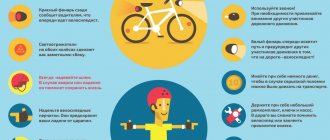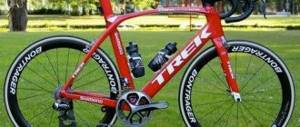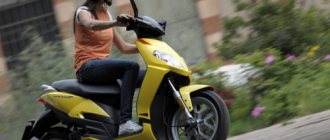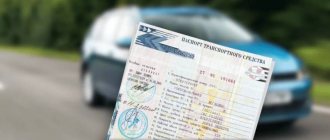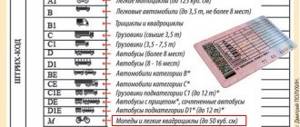General traffic rules for cyclists
The basic provisions of the riding rules for cyclists are set out in Article 24 of the Traffic Regulations, but this is not the only mention of two-wheeled vehicles in the laws. Since 2014, the concept of “bicycle path” has appeared in the rules, and ideally, citizens using this type of transport should only ride along it (Article 24.1 of the Traffic Rules) and always move onto it if one appears in their field of vision. But in fact, they are only in large cities, like Moscow or St. Petersburg, and then on busy avenues. How to cope with this problem for residents of residential areas and small provincial towns will be discussed below.
According to Article 2.3 of the Traffic Regulations, before leaving, the bicycle driver must ensure that his vehicle is fully prepared for the trip: it has working brakes, steering wheel, chassis, inflated wheels, working light signals and a bell.
It is necessary to wear protective equipment such as a helmet or knee and elbow pads. There is no legal obligation for either children or adults to wear these things, and there will be no punishment for their absence, but elementary safety considerations have not been canceled. It is better to cover your eyes with special sports sunglasses.
Should he follow traffic rules?
A bicycle is officially equated to a type of vehicle and, for traffic regulations, is not much different from a car. For this two-wheeler, all the rules that begin with “The driver must…”, “The vehicle must…”, etc. apply. A bicycle does not belong to a mechanical vehicle, so if the test is about them, then it is not for cyclists.
For violations of traffic rules, the cyclist will bear administrative responsibility on an equal basis with other road users.
Expert opinion
Evgeniy Romanov
Lawyer, specializes in protecting rights in areas related to traffic rules, insurance and disputes with the traffic police.
There is a nuance that applies only to this type of transport: if a person gets off the saddle and stands on his feet, then officially he is already a pedestrian and obeys the rules for pedestrians.
Rules for cyclists
There are not so many special traffic rules specifically for cyclists and they are not as strict as for cars, but they still must be followed, especially if you ride a bicycle along country roads.
Along the roadway
The rules for driving on the roadway are regulated in Article 24.2 of the Traffic Regulations. They indicate that you can move along the highway only if there is no special bicycle path nearby or for some reason it is impossible to travel along it. The cyclist must stay strictly at the right edge of the route in the direction of flow, without driving over the strip that separates the road from the side of the road (solid line 1.2.1 or broken line 1.2.2).
When approaching a pedestrian crossing, he must slow down, let people pass and move on, just like cars.
You can also drive on the road if the vehicle has dimensions of more than one meter or is traveling with a trailer whose width is more than one meter. When a whole column of bicycles follows the road, it is permissible for it to move only in one row. You can travel in two columns as an exception if:
- The width of a bicycle with a driver is no more than 0.75 meters;
- No more than ten vehicles are moving;
- Groups with more than ten bicycles must travel in several groups of ten participants. To make overtaking easier, they should stretch out at a distance of 80-100 meters from each other.
The rules do not oblige a cyclist to move off the asphalt onto the dirt shoulder to let passing traffic pass. Motorists must understand that a bicycle is a road user like them, and not a pedestrian.
On the side of the road
According to the traffic rules, you can ride on the side of the road on the right side of the road in the direction of travel if there are no specially designated bicycle paths, sidewalks, pedestrian zones or there is an obstacle to driving along the right edge of the highway.
On the sidewalk or pedestrian path
You can ride on the sidewalk or in the pedestrian zone, if, again, there is no special bicycle path nearby and it is not possible to ride along the right edge of the highway. You also need to move exclusively on the sidewalk if a cyclist under 14 years of age is riding nearby or when transporting a child under 7 years of age in a specially adapted seat or in a stroller. A child under 7 years old must also ride a bicycle exclusively on the sidewalk, accompanied by adult pedestrians.
Paths and lanes for cyclists
Bicycle paths are lanes that are specifically designated in large cities for cycling. Ideally, cyclists should only ride on it. Riding on the sidewalk, in a pedestrian zone, on a highway and in other places not suitable for bicycles, if there is a bicycle path, is prohibited.
A bicycle path is a narrow strip with asphalt surface. Nearby there is a road sign 4.4 “Bicycle path”, or the sign is depicted directly on the asphalt. They come in both one-way and two-way traffic.
How to pass intersections on a bicycle?
The rules for driving through intersections are set out in Article 13 of the Traffic Regulations. If it is not regulated by a traffic light or a traffic controller and is equivalent, then priority in the turn will always go to the one on the right. If the road is uneven (that is, there is a sign 2.1 “Main Road”), then the one moving along the main road goes first. Vehicles on a secondary road allow a car to pass to the right of it.
This does not apply to trams - they always have priority.
If there is a traffic light or a traffic controller, then you need to obey their signals. According to Article 24.8 of the Traffic Rules, a bicycle is prohibited from turning left if the road has more than one lane. He can only move forward and to the right. If he needs to turn left, he will have to dismount and look for a pedestrian crossing to the other side of the highway.
Unfortunately, some drivers are not aware that a cyclist is a participant in the traffic just like himself, and may treat two-wheeled vehicles with disdain. This is a serious misconception.
To avoid exposing himself to unnecessary danger from ignorant drivers, it is best for a cyclist to stop in his lane and patiently wait for other road users to make their maneuver, and only when the road is clear, cross the road himself.
Maximum speed
The cyclist must adhere to the same speed limit that is indicated on the sign for all road users (clause 10.1 of the traffic rules). As a rule, in urban areas the maximum speed limit is 60 km/h; in courtyards and residential areas you cannot drive faster than 20 km/h. If it is almost impossible to exceed the first indicator on a bicycle, then breaking the second is not difficult. On the road you can find even fewer speed limits - all of them are mandatory.
If the bicycle has an electric drive, then at around 25 km/h it should turn off.
Outside the city, the speed limit is, as a rule, beyond the reach of muscle-powered vehicles, so when riding on a country road it is almost impossible for a cyclist to break the speed limit.
Traffic lights and intersections
A two-wheeled vehicle moving along a highway is one of the participants in the movement. Accordingly, at intersections controlled by traffic lights, cyclists are subject to the same rules as motorists. A cyclist has no right to drive beyond the limit line, run through a prohibiting traffic light, or turn around. He should stop before the intersection and wait until the entire column receives the permission signal.
Maneuvering signals and lighting devices
In accordance with Article 8.1 of the Traffic Regulations, a vehicle is required to give signals to start moving, turn, change lanes, brake and stop. Unlike cars, bicycles are not equipped with lights, and the rules require cyclists to signal with their hands when maneuvering.
Nobody forbids installing special equipment with light signals on a bicycle. This way you can significantly facilitate your own movement on the roads.
- Turn left: extend your left arm to the side, or bend your right arm at a right angle and move it to the side;
- Turn to the right: extend your right arm to the side, or bend your left arm at a right angle and move it to the side;
- Stop: raise your left or right hand up.
All these signals should be followed a couple of seconds before starting the maneuver. It is important that other road users can see your sign and react in advance. After the signal is given and you are sure that the drivers have had enough time and opportunity to see it, you can return your hand to the steering wheel and turn.
Avoid performing these signals along with braking with one hand on the handlebars to avoid being thrown out of the saddle.
If the driver of a vehicle moves in the dark, then according to Article 19.1 of the Traffic Regulations, he must have reflective elements with him. For cyclists - reflectors and a flashlight. The white reflector needs to be attached to the front along with the flashlight on, and the red one to the back. It's also a good idea to have reflectors on wheels and wear a jacket with reflective stickers.
Article 19.5 imposes an obligation on drivers to turn on their lights during daylight hours to indicate traffic on the highway. In theory, this also applies to bicycles, but in fact this is not observed on the roads.
For cyclists under 14 years of age
Cyclists under 14 years of age must travel exclusively on the sidewalk or bike path, and only within pedestrian zones. There should not be a situation on the road where a child is driving on the road and his parent is driving on the sidewalk. And vice versa is also prohibited.
On country roads, where there is neither a bike path nor a pedestrian zone, children under 14 years of age are not allowed to ride bicycles, no matter whether there is an adult nearby or not.
A child under 7 years old on a bicycle must be accompanied by adult pedestrians on sidewalks or pedestrian paths. You cannot accompany him on your own bicycle either.
Does a bicycle have the right to ride on the road?
If we consider this issue strictly formally and guided by the definitions from the traffic rules, then all cyclists are one way or another allowed to ride on the road. This is very important in the context of analyzing an accident with a bicycle, if you hit it or it hit a car. This is because the road includes the roadway, the sidewalk, and the shoulder. In general, the movement of cyclists, both small and adult, is allowed on sidewalks, bicycle and pedestrian paths.
But not everyone can move along the roadway and not always. Permitted in the following cases and only on the right edge of the roadway:
- when there are no appropriate bicycle paths, bicycle pedestrian paths, a separate lane for cyclists, or it is not possible to move along them,
- if the dimensions of the bicycle, cargo or trailer for the bicycle are large, namely more than 1 meter in width,
- if there is a whole column of two-wheelers.
At the same time, the age of such bicycle drivers must exceed 14 years.
With the same age limit, you can drive along the side of the road when there are no special paths, a special lane, or it is not possible to move along them or along the right edge of the driveway.
If none of the above are available or there is no way to move along them, then you can ride your bike on the sidewalk or pedestrian path.
Those reckless drivers who are from 0 to 14 years old can ride a bicycle only on special paths, sidewalks and within pedestrian zones.
Cyclist privileges
Recently, cyclists have received an advantage: they are allowed to move in a dedicated lane for route vehicles. Such roads are indicated by blue road signs (5.11, 5.13.1, 5.13.2, 5.14). Apart from passenger taxis, school buses and bicycles, no type of transport is allowed to appear on it. However, there is a nuance: a cyclist can only enter it if it is located on the right and there are no bicycle paths nearby.
Basic terms
First of all, let's get acquainted with the basic terms and definitions that cyclists need to know.
"Bike"
- a vehicle, other than a wheelchair, which has at least two wheels and is generally driven by the muscular energy of the occupants of the vehicle, in particular by means of pedals or handles, and may also have an electric motor of rated maximum continuous power load not exceeding 0.25 kW, automatically switching off at speeds over 25 km/h.
The main thing to note is that a bicycle is a vehicle.
. All requirements of the Rules relating to vehicles apply equally to bicycles.
The bicycle can be equipped with an electric motor with a power of no more than 0.25 kW with automatic shutdown at speeds over 25 km/h.
Bicycle with electric motor
"Cyclist"
- person driving a bicycle.
Cyclist - controls a bicycle. If you drive a bicycle nearby, then you become a pedestrian.
Cyclists and pedestrians
"Bike Lane"
(or a separate road)
structurally separated from the roadway and sidewalk , intended for the movement of cyclists and marked with sign 4.4.1.
The bicycle path is structurally separated from the roadway or sidewalk, and can also be made in the form of a separate road, that is, form full-fledged intersections with highways. To designate it, it is necessary to have a road sign “Bicycle path”.
Bike Lane
"Driver"
- a person driving
a vehicle
, a driver leading pack animals, riding animals or a herd along the road. A driving instructor is treated like a driver.
The cyclist is also a driver.
"Pedestrian and bicycle path (pedestrian and bicycle path)"
- a road element (or a separate road) structurally separated from the roadway, intended for the separate or joint movement of cyclists with pedestrians and indicated by signs 4.5.2 - 4.5.7.
A relatively new element of the road in the Traffic Rules, intended for joint or separate movement of cyclists and pedestrians.
Bike and pedestrian path
"Lane for cyclists"
- a lane of the roadway intended for the movement of bicycles and mopeds, separated from the rest of the roadway by horizontal markings and marked with sign 5.14.2.
The latest innovation in the traffic rules is a special dedicated lane on the roadway, the same as for the movement of route vehicles. In addition to bicycles, it is also intended for the movement of mopeds.
Cyclist lane
Back to contents
Cyclists are prohibited
- Driving a vehicle without hands on the steering wheel - reckless driving and driving with just your legs are unacceptable;
- Drive with a load that extends beyond the dimensions by more than 0.5 meters in any direction or interferes with control;
- Transport passengers on a frame, on a trunk or in any other way that is not provided for by the design;
- Transport a child without a specially equipped seat;
- Drive along pedestrian crossings;
- While in the right traffic, turn around or turn left on tram lines, or on a highway with two or more lanes - unless there is a special sign on the road allowing a turn or if the road does not pass in a special bicycle zone;
If you urgently need to turn left, you can get off your bike and, like an ordinary pedestrian, cross to the other side of the road along the zebra crossing, driving traffic nearby.
- Tow another bicycle (if there is no special towing trailer on which another vehicle is securely attached);
- Drive on highways;
- Talk on the phone while holding the steering wheel with one hand.
Fines for cyclists and common mistakes
Now let's talk about how not to ride a bike.
Drunk on a bike
A bicycle is also a type of vehicle that can pose a danger to others, and the person in the saddle is its driver. Accordingly, if you appear on it while intoxicated, this will be considered a violation of Article 2.7 of the Traffic Regulations, which directly prohibits driving any vehicle while drunk.
It is also not allowed to hand over control to a drunk person. In this case, the owner of the bicycle will also be responsible.
When is it prohibited to use a bicycle?
It is prohibited to cross the road along the pedestrian crossing while riding a bicycle. Only people can move along them on foot, so if a cyclist needs to cross the zebra crossing, he will have to dismount and go through the crossing, driving his vehicle nearby. This is especially true for areas that are not controlled by traffic lights.
This ban applies primarily for the safety of the cyclist himself, since a cyclist is not able to stop abruptly with the same success as a pedestrian. In addition, he, as a rule, moves faster than a person, and there is a high probability of not noticing an approaching car.
You should also not drive if the bicycle has faulty or no brakes. Among young people, dismantling “extra and heavy” brakes is a common practice that runs counter to Article 2.3.1 of the Traffic Regulations, which obliges the driver to have a working brake system.
Also, according to paragraph 6 of the “Basic provisions for the approval of a vehicle for operation”, you cannot drive a bicycle if the steering wheel is broken, the sound signal is broken, there are no reflectors in the front, rear and sides for riding at night.
If the movement of a cyclist threatens other road users or creates a danger for persons in pedestrian areas, then he must dismount and continue moving as a pedestrian.
Can a bicycle overtake?
A cyclist can overtake other vehicles, but he has the right to do this only under Article 11 of the Road Rules, which regulates safe overtaking. You can overtake other cars if:
- The cyclist is confident that the road ahead is clear and he will not create a danger for other vehicles;
- Overtakes on the left side;
A cyclist is prohibited from overtaking if:
- The vehicle in front begins to overtake itself or goes around an obstacle;
- The vehicle is turning left or has just turned on the left turn signal;
- A safe return to the runway is not possible.
Overtaking is prohibited at pedestrian crossings, at railway crossings and within one hundred meters of them, on and under bridges, tunnels, controlled and unregulated intersections, unless the cyclist is traveling on the main road, as well as in places with poor visibility.
How to transport a child on a bicycle
A child can be transported on a bicycle in two cases:
- The manufacturer's design includes a special seat with seat belts and a handle;
- It has a trailer or stroller mount that you can safely place your child in.
Transporting children on a frame, trunk, on a makeshift seat or stroller is strictly prohibited.
Fine for violating traffic rules by a cyclist
A cyclist may be fined:
- For driving while intoxicated under Article 12.29, paragraph 3 of the Code of Administrative Offenses of the Russian Federation - from 1,000 to 1,500 rubles;
- Violation of traffic rules under Article 12.29 clause 2 of the Code of Administrative Offenses of the Russian Federation – 800 rubles;
- Interference with other road users under Article 12.30 clause 1 of the Code of Administrative Offenses of the Russian Federation – 1,000 rubles.
- Harm to human health under Article 12.30 clause 2 of the Code of Administrative Offenses of the Russian Federation - from 1,000 to 1,500 rubles.
- Talking on a mobile phone while driving under Article 12.36 of the Code of Administrative Offenses of the Russian Federation – 1,500 rubles.
Will my driver's license be revoked if I'm caught riding my bike drunk?
Many cyclists mistakenly believe that riding a bicycle does not carry any responsibility. Despite the fact that regulatory authorities pay minimal attention to cyclists, the law still provides for liability for driving while intoxicated. At the beginning of the article, we noted that a bicycle is a vehicle, and a cyclist is a driver.
The rules specifically prohibit driving any vehicle while intoxicated.
2.7. The driver is prohibited from:
- drive a vehicle while intoxicated (alcohol, drugs or other), under the influence of medications that impair reaction and attention, in a sick or tired state that jeopardizes traffic safety;
Can my driving license be revoked if I'm caught riding a bicycle while drunk? Let us turn to the article of the Code of Administrative Offenses of the Russian Federation according to which drunk drivers are punished:
1. Driving a vehicle by a driver who is intoxicated, if such actions do not constitute a criminal offense, -
shall entail the imposition of an administrative fine in the amount of thirty thousand rubles with deprivation of the right to drive vehicles for a period of one and a half to two years.
At first glance, it seems that the article is entirely suitable for cyclists and employees may try to attract attention based on it. However, riding a bicycle does not require a special driving license and obtaining, as well as deprivation of, such a right has nothing to do with driving a bicycle. For cyclists, the Code of Administrative Offenses of the Russian Federation provides a special article defining liability.
Please note that if you drive a scooter or moped while intoxicated, the application of this article is completely legal. The only exception for this article is cyclists.
Back to contents
How to behave in case of an accident
The algorithm of actions is described in Article 2.5-2.6 of the Traffic Regulations. If a cyclist does become involved in an accident, he should:
- Make sure that you remain intact and there are no serious wounds; if someone else is injured, call an ambulance by calling 103 or 112;
- If he collides with a car, the driver must put up a warning triangle and turn on the hazard warning light;
- Do not touch the bicycle - let it lie where it fell;
- If you need to receive compensation for the repair of your vehicle, call the traffic police at 102;
- While the inspector is driving, take out your smartphone and take a photo of the bicycle and the other participant in the accident - this will help the arriving traffic police officer to reconstruct the picture of the events;
- Once all the photos have been taken, the bike can be removed from the road if it is obstructing traffic;
- As soon as the traffic police car arrives, report your version of events and ensure that it is correctly reflected in the protocol;
- The inspector must draw up a report and give a copy of it, along with a certificate of the accident, to the participants in the accident. These papers will be needed if the case goes to court.
In Russia, where bike paths have only recently begun to appear, riding through a densely populated city can be quite an adventure, and it is not always possible to strictly follow the rules. It is unlikely that anyone will actually impose fines if a cyclist rides on the wrong side of the road. But keeping legislative norms in mind is important and necessary when controversial situations arise and to protect your rights.
